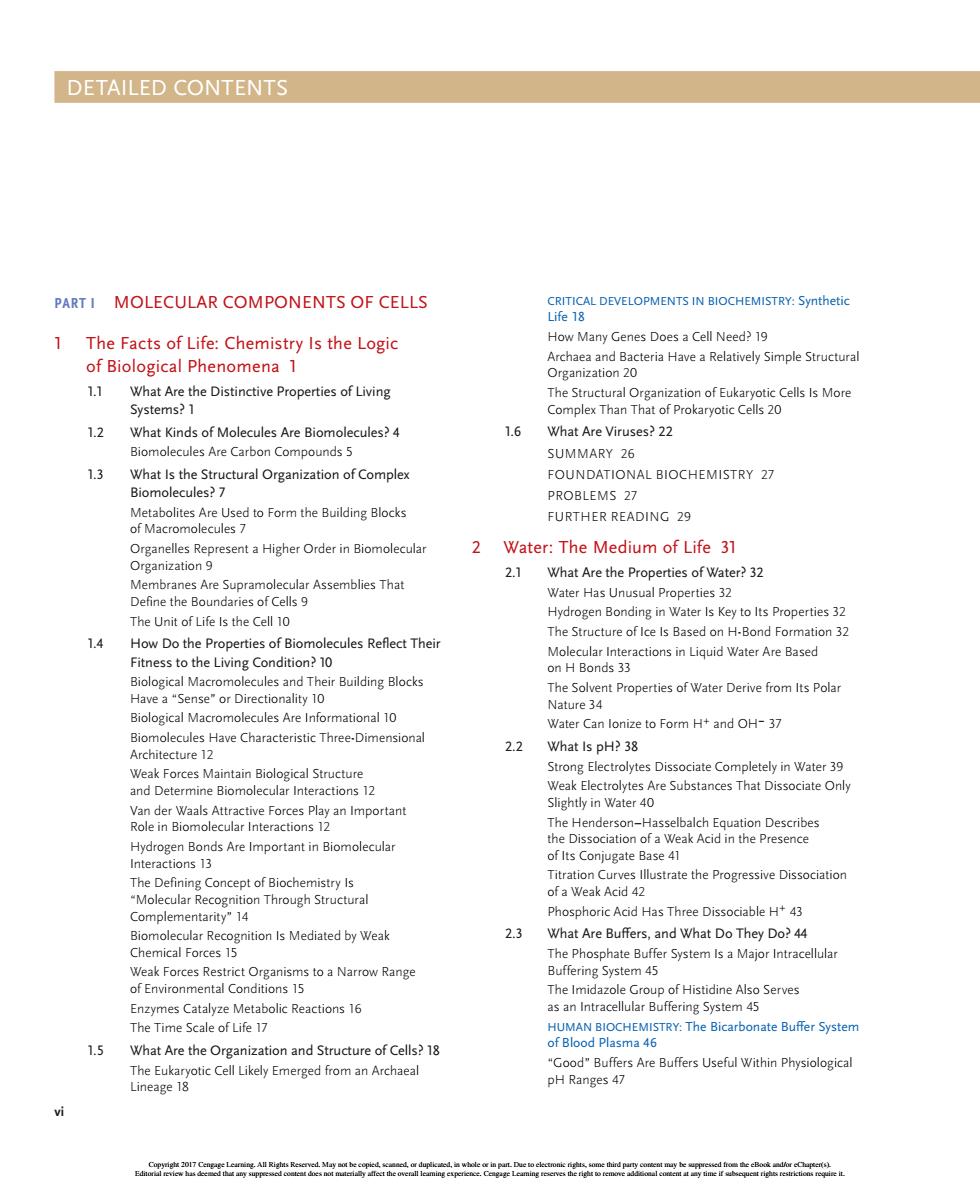正在加载图片...

DETAILED CONTENTS PARTI MOLECULAR COMPONENTS OF CELLS EgoaaowenswBooenTrSrte 1 The Facts of Life:Chemistry Is the Logic How Many Genes Doesa Cell Need?1 of Biological Phenomena 1 1.1 What Are the Distinctive Properties of Living The structural oreanization of Eukaryotic cells is more Systems?1 Complex Than That of Prokaryotic Cells 20 1.2 What Kinds of Molecules Are Biomolecules?4 1.6 What Are Viruses?22 Biomolecules Are Carbon Compounds 5 SUMMARY 26 13 FOUNDATIONAL BIOCHEMISTRY 27 PROBLEMS 27 Metabolites Are Used to Form the Building Blocks FURTHER READING 29 of Macromolecules 2 Water:The Medium of Life 31 21 What Are the Properties of Water?32 Water Has Unusual Properties 32 The Unit of Life is the Cell 10 Hydrogen Bonding in Water Is Key to Its Properties 32 14 The Structure of lce Is Based on H-Bond Formation 32 How Do the Properties of Biomolecules Reflect Their Fitness to the Living Condition?10 olbgcdlhecromeetsandTterBuldinglocs nt Properties of Water Derive from Its Pola omol Water Can lonize to Form H+and OH-37 2.2 What Is pH>38 ctrolytes dissociate co Weak Forces Maintain Biological Structure and Determine Biomolecular Interactions 12 ate Only Slightly in Water 40 The Henderson-Ha n Bonds Are Important in Biomolecular Presenc Titration Curves lustrate the Progressive Dissociation Through Structura of a Weak Acid 42 Phosphoric Acid Has Three Dissociable H+43 Chemedated byWek Biomolecular Rec 2.3 What Are Buffers,and What Do They Do?44 Range Metabolic Reactions 16 Serves HUMAN BIOCHEMISTRY:The Bicarbonate Buffer System 1.5 What Are of Cells of Blood Plasma 46 Hvi Critical Developments in Biochemistry: Synthetic Life 18 How Many Genes Does a Cell Need? 19 Archaea and Bacteria Have a Relatively Simple Structural Organization 20 The Structural Organization of Eukaryotic Cells Is More Complex Than That of Prokaryotic Cells 20 1.6 What Are Viruses? 22 SUMMARY 26 Foundational Biochemistry 27 PROBLEMS 27 Further Reading 29 2 Water: The Medium of Life 31 2.1 What Are the Properties of Water? 32 Water Has Unusual Properties 32 Hydrogen Bonding in Water Is Key to Its Properties 32 The Structure of Ice Is Based on H-Bond Formation 32 Molecular Interactions in Liquid Water Are Based on H Bonds 33 The Solvent Properties of Water Derive from Its Polar Nature 34 Water Can Ionize to Form H1 and OH2 37 2.2 What Is pH? 38 Strong Electrolytes Dissociate Completely in Water 39 Weak Electrolytes Are Substances That Dissociate Only Slightly in Water 40 The Henderson–Hasselbalch Equation Describes the Dissociation of a Weak Acid in the Presence of Its Conjugate Base 41 Titration Curves Illustrate the Progressive Dissociation of a Weak Acid 42 Phosphoric Acid Has Three Dissociable H1 43 2.3 What Are Buffers, and What Do They Do? 44 The Phosphate Buffer System Is a Major Intracellular Buffering System 45 The Imidazole Group of Histidine Also Serves as an Intracellular Buffering System 45 Human Biochemistry: The Bicarbonate Buffer System of Blood Plasma 46 “Good” Buffers Are Buffers Useful Within Physiological pH Ranges 47 Part I Molecular Components of Cells 1 The Facts of Life: Chemistry Is the Logic of Biological Phenomena 1 1.1 What Are the Distinctive Properties of Living Systems? 1 1.2 What Kinds of Molecules Are Biomolecules? 4 Biomolecules Are Carbon Compounds 5 1.3 What Is the Structural Organization of Complex Biomolecules? 7 Metabolites Are Used to Form the Building Blocks of Macromolecules 7 Organelles Represent a Higher Order in Biomolecular Organization 9 Membranes Are Supramolecular Assemblies That Define the Boundaries of Cells 9 The Unit of Life Is the Cell 10 1.4 How Do the Properties of Biomolecules Reflect Their Fitness to the Living Condition? 10 Biological Macromolecules and Their Building Blocks Have a “Sense” or Directionality 10 Biological Macromolecules Are Informational 10 Biomolecules Have Characteristic Three-Dimensional Architecture 12 Weak Forces Maintain Biological Structure and Determine Biomolecular Interactions 12 Van der Waals Attractive Forces Play an Important Role in Biomolecular Interactions 12 Hydrogen Bonds Are Important in Biomolecular Interactions 13 The Defining Concept of Biochemistry Is “Molecular Recognition Through Structural Complementarity” 14 Biomolecular Recognition Is Mediated by Weak Chemical Forces 15 Weak Forces Restrict Organisms to a Narrow Range of Environmental Conditions 15 Enzymes Catalyze Metabolic Reactions 16 The Time Scale of Life 17 1.5 What Are the Organization and Structure of Cells? 18 The Eukaryotic Cell Likely Emerged from an Archaeal Lineage 18 Detailed Contents Copyright 2017 Cengage Learning. All Rights Reserved. May not be copied, scanned, or duplicated, in whole or in part. Due to electronic rights, some third party content may be suppressed from the eBook and/or eChapter(s). Editorial review has deemed that any suppressed content does not materially affect the overall learning experience. Cengage Learning reserves the right to remove additional content at any time if subsequent rights restrictions require it